Upon arrival in Hanoi you'll be met by your guide who will transfer you to your hotel.
Hanoi, Vietnam's capital, ranks amongst the world's most attractive and interesting cities. It was first the capital of Vietnam in A.D. 1010, and though the nation's capital moved to Hue under the Nguyen dynasty in 1802, the city continued to flourish after the French took control in 1888. In 1954, after the French departed, Hanoi was declared Vietnam's capital once again. The remnants of over 1,000 years of history are still visible here, with that of the past few hundred years wonderfully preserved.
The remainder of your day is at your leisure.



Enjoy a full day tour of Hanoi. Your guide will be happy to personalise your programme, however we would recommend sites such as Ho Chi Minh’s Mausoleum, One Pillar Pagoda and a stroll around Hoan Kiem Lake. For many the Temple of Literature is a highlight worth lingering over. Built in 1070, this complex of atmospheric halls, pavilions and courtyards is dedicated to Confucius and scholars. Of special note are the 82 remaining steles of stone shaped like turtles which are elaborately carved with the names of candidates that sat the Royal examinations. A walking tour through the Old Quarter will provide another fascinating insight into the character and history of the city, before moving on to Dong Xuan Market with its bustling stalls and brisk trading of day-to-day local goods.
After lunch, consider visiting the very popular Ethnology Museum or the central Hoa Lo Prison, nicknamed the Hanoi Hilton by American POW's during the war. Alternatively your guide will be happy to discuss alternative places of interest that you may wish to consider.
In the evening we recommend staying in and around the Old Quarter where there is a large selection of excellent restaurants and cafes to choose from. There is also the amazing 'street-food' such as Pho to be found on every corner!



After an early breakfast it’s a three hour drive from the city to Halong Bay, passing through a number of typical North Vietnamese towns and villages. Upon arrival you will be welcomed aboard your traditional junk; the same style that have sailed the bay for 100’s of years.
A natural wonder of the world and one of Vietnam’s UNESCO World Heritage Sites, the creation of Halong Bay is shrouded in myth. Local legend tells us how the gods sent a family of dragons to defend the country from the invading Chinese. The dragons spat out gemstones that turned into islands, linking together to create a wall against the enemy. The truth is almost as evocative as the legend and upon setting out into the bay you are met by one of the most beguiling natural scenes you will ever witness.
Lunch is served as you depart port. You will soon leave the mainland far behind, navigating amongst the jagged limestone islands and karsts emerging from the emerald waters. Whilst some islands are no more than large rocks others are far more substantial in size.
During your cruise there will be opportunities to disembark, often using smaller boats, or possibly kayaks, to venture into hidden grottos and caves. You will also make stops to explore points of interest such as floating fishing villages and picturesque lookout points.
The cuisine throughout your cruise is both plentiful and of a very high standard. Lovers of fresh seafood will be particularly happy. The dining cabin and bar create a very social atmosphere for those that wish to mix with other guests; whilst cabins, many with a private balcony, are all ensuite and spacious.
Each junk operates a slightly different itinerary (although en-route stops will be the same) and on board facilities vary. Your consultant will be very happy to discuss each option with you.



In the early morning many of the islands are alive with the sound of various sea birds nesting in the thick green vegetation that engulf the limestone karsts. Early risers may wish to start the day with a Tai Chi class, or a cooking class (only available on selected junks), on the top deck as the sun rises over the bay.
Enjoy brunch onboard whilst your junk slowly turns back in the direction of the mainland, stopping at points of interest en route. Arrive back at port in the late morning, disembark, and transfer back to Hanoi in time for your flight to Hue.
Hue remained Vietnam’s capital until 1945, when Bao Dai, the last of the Nguyen emperors, abdicated. Many of Hue’s attractions are found along the banks of the Perfume River that flows through the centre of town. The cuisine is Hue is spicy hot, with lots of chilli. Reflecting its Imperial roots, it is often served in beautifully presented, taster portions, a kind of oriental nouvelle cuisine!



Take a morning boat trip on the romantically named Perfume River, passing the 10-metre thick protective walls of the Citadel on board a Vietnamese ‘dragon boat’. A short distance up river is perhaps Hue’s best-known religious site, the Thien Mu Pagoda with its distinctive seven-storey octagonal tower. Having explored the pagoda and its beautiful grounds, return to Hue via Dong Ba market.
In the afternoon visit the elaborate mausoleums of Emperors Tu Duc and Khai Dinh, two of the eight Nguyen dynasty tombs to be found along the banks of the Perfume River. Considered the most impressive of the bunch, both are extravagant complexes of pavilions, temples, courtyards and lotus-filled lakes. You can also walk through the heavily bombed remains of the Imperial Citadel, built along the lines of Beijing’s Forbidden City and from where the Nguyen Dynasty ruled between 1802 and 1945.
Return to your hotel where there is time to relax and freshen up before your evening tour begins at 5.30pm. Riding pillion on a Vespa, you’ll enjoy a taster of Hue’s distinctive cuisine, whilst taking in the sights of the city by night. Following a short briefing at the Vespa Café, where you will meet your fellow passengers and your driver, head out on the back of your Vespa.
Food is very much the focus of the evening and over the next 4 hours you will visit several local eateries dotted around the city sampling typical, authentic Hue cuisine along the way. Some of the dishes you will taste are ‘Banh Khoai’ - sizzling pancake stuffed with shrimp & pork; ‘Bun Bo Hue’ – Hue’s famous beef noodle soup; ‘Banh Cuon Hue’ – pork BBQ rolls and Hue Cakes which are not sweet as you would expect from the name but rather moreish rice flour snacks typically served with fish sauce.
With your appetite fully satisfied, enjoy a leisurely Vespa ride through the streets of Hue back to your hotel.
Overnight in Hue.



Morning departure for Hoi An, driving the picturesque route via the wonderfully photogenic fishing village of Lang Co and over the Hai Van Pass (Ocean Cloud Pass), before reaching Danang.
Drive the final 25 minutes to Hoi An where the remainder of your day is at leisure.
Once known as Faifo, the UNESCO designated World Heritage town of Hoi An was one of the Orient’s major trading ports in the 16th and 17th centuries. The town is one of the highlights of any visit to Vietnam with its laid-back atmosphere and fine Colonial architecture lining cobbled streets offering a glimpse of times gone-by. Explore the former merchants’ homes, the 450 year-old Japanese Covered Bridge adorned with lanterns by night and the colourful market.
Hoi An is one of the best places in Asia to shop for silks, handicrafts, antiques and art. Also, the local tailors are famous for their high standards of work and can create anything to order in just 24 hours.
A short distance from the town centre is Cua Dai Beach, popular with both locals and visitors for its sandy beach, warm sea and seafood stalls. The town is also famed throughout Vietnam for its fine cuisine and there are a number of sensational restaurants and cafes to choose from.
In more recent years Hoi An has unfortunately lost a little of its previous charm, due to the huge development work around the nearby city of Danang and along the beach road linking the two, increasing the number of day trippers and group tours to the town. We would however still unquestionably recommend it to any first time visitor to Vietnam.



Ask any Vietnamese person where the best cuisine in Vietnam is to be found and 99% of the time the answer will be Hoi An - the food in this town is second to none. Where better to enjoy a food focused experience?
After an early breakfast, saddle up and cycle with your guide to Hoi An’s central market. This bustling morning market sells a wide array of fresh produce, much of which you will be using later in your cooking class. Your guide will help identify the less familiar objects.
Back on your bike, cycle the short distance to the village of Tra Que where you will learn about the traditional gardening methods and rather unique algae fertiliser deployed by the residents of the region. The lack of modern day machinery and technology has helped to preserve skills and knowledge that have been in use for centuries. There will be the opportunity to assist the farmers as they work in the garden, learning more about their community and rural life.
As midday approaches you will be invited to help with the preparation of lunch. Using vegetables and herbs straight from the garden, you’ll learn how to make the local speciality of Tam Huu (spring rolls), Banh Xeo (crispy savoury pancakes), Tra Que steamed chicken, and clay pot fish. After which, sit down and enjoy your home-cooked meal.
After eating, relax with a traditional herbal footbath before returning to Hoi An by car. The remainder of your day is at leisure.



Explore, relax and enjoy the sand....






Morning transfer to to Danang Airport for your flight to Ho Chi Minh. Upon arrival visit the famous Cu Chi tunnels - an incredible underground tunnel network constructed by Vietnamese resistance fighters during the long struggle for independence. The tunnels, over 250km in length and up to three levels deep in places, played a huge part in the Viet Cong’s victory over the Americans, allowing them to control a large rural area surrounding Ho Chi Minh City.
Today, some of the remaining tunnels have been opened to tourists, offering a unique insight into what underground life must have been like during the ‘American’ war. Continue on to Ho Chi Minh City where the remainder of your day is at leisure.
Ho Chi Minh City is the largest city in Vietnam and is located near the Mekong Delta. It was originally Cambodian territory before being conquered by the Vietnamese in the 16th century and named Saigon. The city was then renamed once again, after the North Vietnamese invasion of South Vietnam in 1975, becoming Ho Chi Minh City (named after the North Vietnamese leader).
Today the city centre is still adorned with wide elegant boulevards and historic French buildings. However, as the undoubted economic centre of Vietnam, high rise office towers are starting to take their place amongst this wonderful colonial architecture.
Overnight in Ho Chi Minh City.



After breakfast, set off to tour some of Ho Chi Minh City’s highlights. Your guide will be happy to personalise your programme, but we particularly recommend certain sites; the Reunification Palace, formerly South Vietnam's Presidential Palace, was built in the 1960s and remains largely untouched since the day Saigon finally fell to North Vietnamese troops in 1975. Others offer visitors a sense of the region’s French Colonial past; Notre Dame Basilica was built in the late 1800s, and the pink neoclassic confection that is Saigon Central Post Office was designed by Gustave Eiffel himself. To start your day, however, explore a side of Ho Chi Minh City that few tourists even know exists, let alone get to visit, by plunging into the heart of District 1’s maze of narrow alleyways.
District 1 is famous for impressive architecture like the Basilica, but beyond the neoclassical facades lie some of HCMC’s most densely populated wards, all thronging with daily life, along with significant history of its own. Walk through the small back alleys and towards the local residential areas, with their bustling, colourful, aromatic markets, and a variety of small scale businesses that seem a world away from the city you have seen up until this point.
Stop to observe a Viet Cong secret weapons store, where undercover commandos of the Viet Cong’s North Vietnamese Army collected munitions before launching the Tết Offensive, on 30 January 1968, with the sound of Tết (New Year) firecrackers disguising the gunfire. Fighting continued for months in an episode that has been described as the ‘bloodiest’ phase in the Vietnam-American War, and which triggered much anti-war sentiment in America.
The weapon store, now recognised as a National Historical Site, went undetected for many years and played a key part in the VC's Saigon offensive. Much of the extensive weaponry kept there is still on display, and visitors can learn about the clever methods used to smuggle and conceal it.
Having visited a few of the aforementioned stately landmarks, continue to Cho Lon, which has been HCMC’s Chinatown since 1778. Taste the local favorite noodle dish for lunch, followed by a visit to Quan Am Pagoda, a Chinese style Buddhist pagoda built during the 19th century, with beautifully decorated interiors. As you explore Chinatown, you will see all manner of goods on sale, from dragon artwork, masks and pet fish, to sacks of rice, fabric and cooking utensils.
Leave Chinatown for newer developing areas, observing a visual feast of old and new architecture side by side, before a drive by what was once known as the 'Southern stomach' - specifically, the city’s largest rice market, founded by the Chinese in the 18th century. Having thoroughly explored HCMC, finish the tour in fine style by heading up the Bitexco Tower, which is the city’s tallest building. Your guide will be happy to wait for a short while, whilst you enjoy a stylish sundowner with breath-taking skyline views; those wanting more time may choose to take a taxi back to their hotel at a later stage.



Early morning transfer to Cai Be where you will board your own, private traditional sampan; the type of boat that has been used on the delta waters for centuries. Your crew will consist of boat-driver, deckhand, and a local guide.
Your journey begins with a bicycle ride around this remote countryside area, ending up at Le Longanier Restaurant. Lunch is served in this exquisite colonial-style villa set in a lush tropical garden by the river.
After lunch, start your leisurely cruise along the Delta’s waterways, with stops along the way to explore local cottage industries that provide a living for the river people and a traditional pottery factory where everything is made by hand.
Eventually you will arrive at Sa Dec where there is the chance to disembark and take a walk around the charming town; complete with a number of beautiful old French houses, Chinese temples and a central market. Visit an ancient house dating from 1890 which is the home of Mr. Huynh Thuy Le, 'the Lover' in Marguerite Duras' famous novel.
Your evening meal will be served at a local house where you will be able to share experiences with family members and learn more about the traditional southern lifestyle, before returning to your sampan for your first night on the Mekong River.
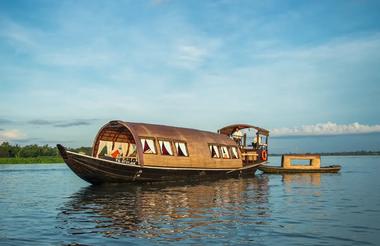

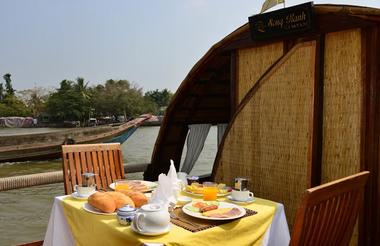
Enjoy breakfast on board as your private sampan continues cruising the delta waterways, passing along narrow canals, through peaceful countryside and under wooden ‘monkey bridges’ that the Mekong Delta region is well known for.
In the early afternoon, following lunch, you will arrive at Long Xuyen, a typical provincial town situated on the riverbanks and home to an attractive floating market. During the afternoon there will be time to explore Tiger Island (Cu Lao Ong Ho), where there is a museum dedicated to Ton Duc Thang, the second president of Vietnam.
Return to your sampan where dinner is served as you cruise towards Chau Doc, anchoring for the night around 10pm.
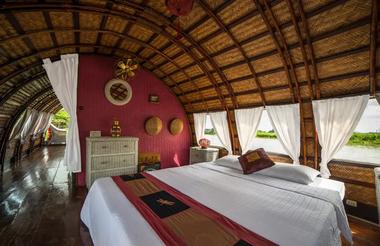

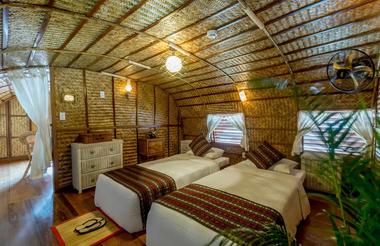
Wake up to the sound of the Mekong River and take an early on-board breakfast. As you approach Chau Doc, watch the locals go about their daily work, drying exotic fruits and building ships close to the river banks.
Arrive in Chau Doc mid-morning, disembark and you will be met by staff from your hotel. You now have time to relax and watch river life on the Mekong River. Chau Doc is a laid back place and the beautiful Victoria Hotel, on the river bank, is the ideal location to soak up the lazy delta atmosphere. The remainder of your day is at leisure to watch the sun set over the Cambodian border.
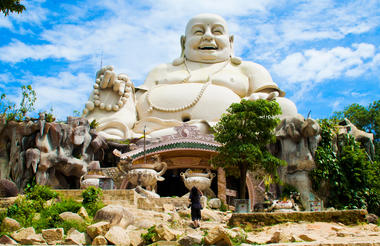
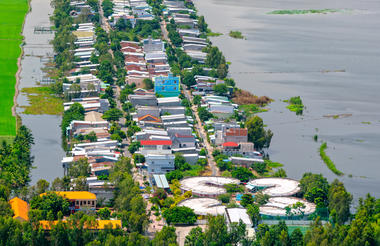

Enjoy a morning boat ride up the Mekong Delta from the Vietnamese border to Phnom Penh (depart approx 7am, arrive approx midday). Weave your way through some stunning delta scenery before arriving at Phnom Penh.
Phnom Penh was once considered one of the most beautiful cities in the Orient and despite its recent turbulent history it still retains a certain Colonial charm. Today this rapidly developing city buzzes with energy and an air of opportunity as Cambodia advances into the 21st century. A great place to find yourself at sunset is on the banks of the Mekong River with a cold drink, watching the city slow down.
Your afternoon is at leisure until 5pm when you will be met by your guide in a tuk-tuk, your transportation for the evening, for a memorable food-focused experience.
First stop is the Foreign Correspondents Club, more commonly known as the FCC. This legendary colonial watering hole oozes history, having been the social hub for foreign journalists and aid workers during the Khmer Rouge era. Some interesting memorabilia adorns the walls which your guide will talk you through, before leaving you on the rooftop terrace to enjoy a cocktail and views across the Mekong & Tonle Sap rivers as the sun sets.
Re-joining your guide in the tuk-tuk, it’s time for a completely contrasting experience…Cambodian's don’t shy away from entomophagy (that’s ‘snacking on insects’ in layman’s terms), and they have long been seen as a good source of nutrition. Head down to the river where roadside stalls sell a variety of edible bugs which you will have the opportunity to try. Your guide is on hand to decipher the surprisingly tasty offerings.
Continue by tuk-tuk to the Russian Market. By day this market is a tourist hotspot, but come evening the food stalls come alive, attracting local diners with typical Khmer food such as Banh Chheo, chicken rice porridge and beef skewers. Choose what you wish to eat, pull up a plastic stool alongside the locals and soak up the atmosphere. Next up, and your final food stop for the evening, are the popular seafood stalls where you can enjoy freshly barbequed seafood before returning to your hotel, again by tuk-tuk.



In 1975, after years of guerrilla warfare, the radical Communist Khmer Rouge party, under its leader Pol Pot, seized power of Cambodia and declared ‘year zero’. They immediately abolished money and private property, and ordered the entire population of Phnom Penh from their homes and into the countryside to cultivate the fields. Over the next three years an estimated 2 million Cambodians died, many from starvation and exhaustion. Many others were tortured and executed for being supposed ‘enemies of the state’.
The morning is spent learning more about these terrible years, through visits to the infamous Tuol Sleng Museum of Genocidal Crimes and Cheung Ek, better known as the ‘Killing Fields’. It is an incredibly moving experience, but these are two visits you will be glad to have made. During your visit to Cambodia, you will barely meet a single person who didn’t lose a member of their family during these years, yet they are all willing to talk openly about it with you. They wish you to hear about it and see these places, to ensure that it never happens again.
Lunch is at Friends, a ‘kindness restaurant’ where ex-street children are trained in hospitality and restaurant skills, helping them to break away from life on the streets.
In the afternoon visit the Royal Palace, situated on the site of the former citadel and built by King Norodom in 1866, the Palace still serves as the King and Queen's residential quarters. Also within the walls of the Palace is the Silver Pagoda, so called because of five thousand silver tiles that line its exquisite floor. If time permits there is also the option of visiting the National Museum, which houses the worlds leading collection of Khmer art and sculpture, and Wat Phnom the founding site of the city. All are within easy walking distance of each other and are a great introduction to this laid-back city.
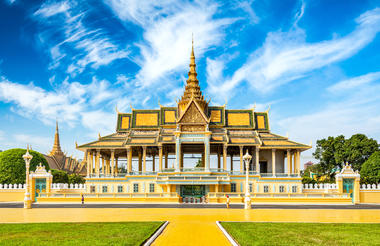


Morning departure for Siem Reap by car (driver only). Taking approximately 5 hours, you’ll pass through provincial towns, villages and roadside hamlets offering you an insight into life away from Siem Reap and Phnom Penh. There will be the opportunity to stop at Skun Village, famous for its deep-fried tarantulas, if you so wish, and stretch your legs and enjoy a coffee in Kampong Thom. Upon arrival, transfer directly to your hotel.
Siem Reap is the base for exploring the fabled temples of Angkor, the ancient capital of the Khmer empire and a UNESCO World Heritage Site. Over 100 temples are spread over a vast area and the site easily lives up to its status as one of the seven wonders of the forgotten world.
Siem Reap has expanded at a phenomenal rate in recent years, with another hotel seemingly opening every other month. However, the old town retains much of its original charm and there are a number of sites of interest such as museums, galleries and the local market. The town also has a wide choice of restaurants and bars, with something to suit every taste.
During any visit to the Angkor temples, we ensure your day(s) remain both flexible and personal. Having met with your guide, you will be able to discuss in detail what you are looking to achieve from your time at the temples. Whilst some wish to explore as many temples as they can during their stay, others like to travel at a slower, more relaxed pace.
Maximum experience, minimum crowds
Whether it’s sunrise at Angkor Wat or sunset at Pre Rup, climbing through the snake like roots that engulf Ta Prohm or swimming in the quiet waters of the West Baray Reservoir (or a combination of these), you can be sure that your visit to one of the seven wonders will not be easily forgotten. Unlike some archaeological tours, the Angkor temples never seem to lose that initial ‘wow factor’. Every site is as outstanding as the last, and it will be with a mixture of regret and excitement that you'll get back into your air-conditioned transport to visit the next site. We do still appreciate that some visitors are wary of becoming ‘templed-out’ and to combat this we can create more varied days with visits to other sites such as floating villages and flooded forests on the Tonlé Sap Lake, museums and exhibitions, cooking schools or simply time at leisure to explore Siem Reap or laze by the pool.
Your guide
All our guides are highly experienced Angkor specialists, fully trained and licensed to work at the temples. Along with their exceptional knowledge of each temple and the civilisations that built them, Selective Asia’s guides know how best to avoid the bus-loads that descend on any given temple at certain times of the day, and know every trick in the book when it comes to getting the best photos and the most tranquil moments.
If you have any specific requirements or special interests, be sure to let us know and we will arrange the guide with the most suitable expertise.
Additional Temples
You may also wish to consider visiting some of the further lying such as Beng Melea & Koh Ker, Sambor Prei Kuk or Preah Vihear. Excursions to these less-visited temples always enhance your experience however they do change things logistically and therefore visits must be arranged well in advance of your arrival.



Continue your tour of the Angkor temples, with your guide and driver at your disposal throughout the day. As with all your temple touring, the sites you visit are flexible and you can discuss your preferences and the best route with your guide.
The shape and scale of this ancient kingdom is, even today, still changing. Over recent years cutting-edge technology has assisted archaeologists in uncovering new temples and historical sites, and discoveries made as recently as 2015 indicate the Angkor kingdom is more expansive than previously thought and was more densely populated. Beneath the forest floor, an elaborate system of roads and waterways (ground-breaking at the time) has been revealed that connected Angkor with outlying temple cities such as Koh Ker and Preah Khan. Common houses made of wood and thatch have also been identified around the temple, despite rotting away thousands of years ago. The latest archaeological research means our guides are able to offer an even greater insight into life in the kingdom of Angkor.
For those that wish, a day of temple exploration by bicycle can be arranged. Cycling is a great way to traverse the area, allowing you to control the pace of your day, and thanks to the flat terrain the going is easy. If this sounds of interest, speak to your Selective Asia consultant for more details.



Departing after breakfast accompanied by your guide, your day will be spent travelling through a number of relatively untouched villages and learning about the day-to-day lives of the local people. This is a world away from Siem Reap, and provides you with the perfect opportunity to get ‘off the beaten track’ and gain a better understanding of Cambodian rural life, along with an insight into traditional Khmer culture; something which few visitors are lucky enough to experience.
Your first stop is the village of Krabei Real, where there is time to explore the local market and to purchase some supplies for your lunch. Continue on, this time without the benefit of air-conditioning, using a more typical method of transportation for this region. The (almost!) pollution free ox and cart is still widely used throughout Cambodia, and allows you to travel at a gentle, almost hypnotic pace along the narrow, sandy, village roads. Winding your way through the rice fields, you’ll pass houses, schools and pagodas. Many of the families in this area are skilled rattan weavers, using techniques passed down through the generations to create a wide variety of crafts and day-to-day items to sell in the markets of the nearby towns.
After around an hour, arrive at the home of a local family who have been carefully chosen by our team. Having been welcomed by your hosts, there will be plenty of time to relax and chat with the family as they prepare lunch using the produce selected at the market (with your guide acting as interpreter). If you wish to assist then you are very welcome to do so, and this is also a fantastic opportunity to further your understanding of typical Khmer cuisine. This is likely to be very different from the dishes you may have sampled in the more westerner-orientated restaurants of Siem Reap and Phnom Penh!
Having enjoyed your lunch, there is time to explore the village before returning to Siem Reap. En route, stop to visit the workshops of the Angkor Artwork - all products sold are produced using long forgotten traditional methods and the quality of craftmanship is outstanding. If time permits, make a stop at Siem Reap’s market before arriving back at your hotel. The remainder of your day is at leisure.



Your day is at leisure until your transfer to Siem Reap Airport for your onward flight.






